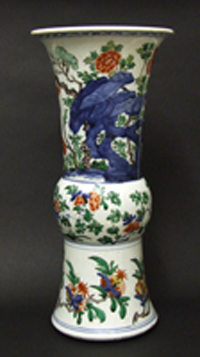
SHUNZHI. c.1645 – 1660. Transitional Porcelain.
A Transitional Porcelain Vase, Shunzhi Period 1644-1661. This Wucai Gu-Shaped Vase is Decorated with Plants Pomegranate and Scholars Rocks. The Cracked Ice Border Below the Rim in Under-Glaze Cobalt Blue.
SOLD
- Condition
- Perfect.
- Size
- Height : 39 cm (15 1/4 inches)
- Provenance
- N/A
- Stock number
- 17682
Information
Wucai Means Five Coloured Enamels. These are Red, Green, Yellow, Blue (underglazed) and the White of the Porcelain Itself.
SHUNZHI 1644-1661 :
The Shunzhi emperor (lived 1638 to 1661) was the second emperor of the Manchu Qing dynasty, and the first Qing emperor to rule over China proper. He ascended to the throne aged five (six sui according to traditional Chinese count) in 1643 upon the death of his father, Hong Taiji, but actual power during the early part of his reign lay in the hands of the appointed regents, Princes Dorgon and Jirgalang. With the Qing pacification of the former Ming provinces almost complete, he died still a young man, although in circumstances that have lent themselves to rumour and speculation.
In the midst of much upheaval, the Manchus seized control of Beijing in June 1644, and in October of the same year the Shunzhi emperor's uncle, the chief regent Prince, proclaimed the Qing dynasty to be the legitimate successor to the Ming dynasty. Therefore, although the Shunzhi emperor was not the founder of the Qing dynasty, he was the first Qing emperor of China.
His mother was Empress Dowager Xiao Zhuang Wen who was an excellent politician during the period. The young emperor disliked his uncle, the chief regent Prince Dorgon, and after Dorgon's death in 1650 the emperor stripped both him and Dorgon's brother, Prince Dodo, of their titles, although he was only 12 years old at the time.
During his short reign, the Shunzhi emperor encouraged the Han Chinese to participate in government activities. He was a scholar and employed Han Chinese to teach his children.
The emperor married his mother's niece, but demoted the empress several years later. Four months after his favourite concubine passed away, he died of smallpox. Before he passed away, he appointed four regents to help his son, Hiowan Yei. They were Oboi, Sonin, Suksaha and Ebilun. It was believed that the young emperor did not pass away but left the palace to become a monk.
For a similar Shunzhi Porcelain Gu vase See : Shunzhi Porcelain, Treasures from an Unknown Reign (Butler, Curtis and little, University of Washington Press,2002) Page 43.
The Pomegranate (Punica granatum) is a fruit-bearing deciduous shrub or small tree growing to 5–8 m tall. The pomegranate is believed to have originated in eastern Iran and southern Afghanistan region, but its true native range is not accurately known because of millennia of extensive cultivation. The leaves are opposite or sub-opposite, glossy, narrow oblong, entire, 3–7 cm long and 2 cm broad. The flowers are bright red, 3 cm in diameter, with five petals (often more on cultivated plants). The fruit is between an orange and a grapefruit in size, 7–12 cm in diameter with a rounded hexagonal shape, and has thick reddish skin and many seeds, demonstrating parietal placentation. The edible parts are the seeds and the brilliant red seed pulp surrounding them. There are some cultivars which have been introduced that have a range of pulp colours like purple. The only other species in the genus Punica, Socotra Pomegranate (Punica protopunica), is endemic to the island of Socotra. It differs in having pink (not red) flowers and smaller, less sweet fruit. Pomegranates are drought tolerant, and can be grown in dry areas with either a Mediterranean winter rainfall climate or in summer rainfall climates. In wetter areas, they are prone to root decay from fungal diseases. They are tolerant of moderate frost, down to about -10°C. Contents The Shunzhi emperor (March 15, 1638 - February 5, 1661) was the second emperor of the Manchu Qing dynasty, and the first Qing emperor to rule over China proper. He ascended to the throne aged five (six sui according to traditional Chinese count) in 1643 upon the death of his father, Hong Taiji, but actual power during the early part of his reign lay in the hands of the appointed regents, Princes Dorgon and Jirgalang. With the Qing pacification of the former Ming provinces almost complete, he died still a young man, although in circumstances that have lended themselves to rumour and speculation. In the midst of much upheaval, the Manchus seized control of Beijing in June 1644, and in October of the same year the Shunzhi emperor's uncle, the chief regent Prince, proclaimed the Qing dynasty to be the legitimate successor to the Ming dynasty. Therefore, although the Shunzhi emperor was not the founder of the Qing dynasty, he was the first Qing emperor of China. His mother was Empress Dowager Xiao Zhuang Wen who was an excellent politician during the period. The young emperor disliked his uncle, the chief regent Prince Dorgon, and after Dorgon's death in 1650 the emperor stripped both him and Dorgon's brother, Prince Dodo, of their titles, although he was only 12 years old at the time. During his short reign, the Shunzhi emperor encouraged the Han Chinese to participate in government activities. He was a scholar and employed Han Chinese to teach his children. The emperor married his mother's niece, but demoted the empress several years later. Four months after his favourite concubine passed away, he died of smallpox. Before he passed away, he appointed four regents to help his son, Hiowan Yei. They were Oboi, Sonin, Suksaha and Ebilun. It was believed that the young emperor did not pass away but left the palace to become a monk.


